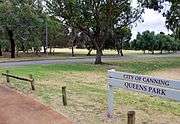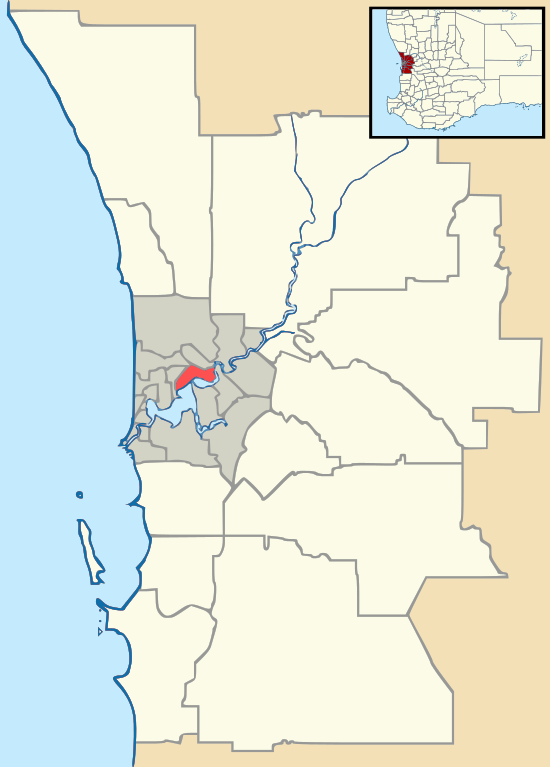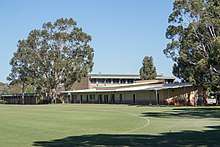Queens Park, Western Australia
Queens Park is a suburb of Perth, Western Australia, located within the City of Canning. Its postcode is 6107.
| Queens Park Perth, Western Australia | |||||||||||||||
|---|---|---|---|---|---|---|---|---|---|---|---|---|---|---|---|
 Queens Park, City of Canning. | |||||||||||||||
 Queens Park | |||||||||||||||
| Coordinates | 32.004°S 115.942°E | ||||||||||||||
| Population | 3,903 (2006 census)[1] | ||||||||||||||
| Postcode(s) | 6107 | ||||||||||||||
| Location | 11 km (7 mi) from the Perth CBD | ||||||||||||||
| LGA(s) | City of Canning | ||||||||||||||
| State electorate(s) | Cannington | ||||||||||||||
| Federal Division(s) | Swan | ||||||||||||||
| |||||||||||||||
There is 6,853 persons living in Queens Park. The top 5 ancestries represented in the suburb were English, Chinese, Australian, Indian and Filipino. The majority of persons living in Queens Park were between the ages of 18 and 49 (school leavers, university students, young workforce and parents and home builders).[2]
Pre colonial history
Queens Park, prior to colonial interactions, was originally cared for by the Whadjuk Noongar people, the traditional owners for the areas along the Djarlgarro Beeliar or Canning River (Western Australia) [3] Prior to the colonial settlement of the area, the Canning River and its associated wetlands provided an important source of food and shelter to the Beeliar and Beeloo Noongar people. The Beeloo considered north of the Canning River, Dyarlgarro, to the hills as part of their ground while the Beeliar mainly traversed the southern section of the river to the sea. At the time of colonial settlement, Midgegooroo and Munday were leaders of these people. The Cannington-Wilson area was called ‘Beeloo’ for many years by local residents.
Post colonial history
The suburb derives its name from the former Queens Park Road Board that was incorporated into the Canning and Belmont Road Boards.[4]
Queens Park was originally known as Woodlupine.[5] The name change was brought about following a murder in 1911.[6] Local residents and authorities feared the incident could jeopardise the development of the area. It was agreed that the name would be changed to Queens Park to honour Queen Alexandra, wife of King Edward VII.[7]
Sister Kate Children Home
The largest single land-holder in Queens Park was Sister Kate's children's home which was founded by Sister Kate in 1934 and expanded in 1936 which at the time, A. O. Neville, the government Chief Protector of Aboriginals was the architect of an official scheme which oversaw the care, custody and education of Aboriginal and half-caste children under 16 years in the state. The scheme's purpose was to integrate young and part Aboriginal children into white society by separating them from their families.[8]
From an Indigenous perspective, Sister Kate's was a 'home' where children from the Stolen Generations were sent after being literally kidnapped from their parents and family. As the aspiration of Sister Kate was to open a home for half-caste Aboriginal children, for "the most poorest and neglected children", she was authorised to open her home in 1933 by Western Australia's notorious Chief Protector of Aborigines, A. O. Neville, specifically for light skinned Aboriginal children. This was for the explicit aim of destroying the childrens' Aboriginal identity and assimilating them in white society, i.e. to "breed out the black" and eliminate Aboriginal culture in Western Australia.[9]
Sister Kate died in 1946, and after her death her so-called 'home' degenerated from a manipulative, evil place which attempted to brainwash kidnapped children into hating their own parents and culture, into a hell on Earth where children were routinely abused both physically and sexually - still with the aim of destroying Aboriginal culture.[10]
The process by which the separation was done has since been widely condemned when a report entitled Bringing Them Home was published in 1997 following a federal government inquiry. These people are now known as the Stolen Generation.
Whadjuk Noongar Heritage Sites
- DAA have site 3633 located on Sevenoaks street in Queens Park.
Colonial Heritage
- The Chapel of the Guardian Angel
- Sister Kate's Children's Home
- St Josephs R.C. School & Convent
- St Norbert College & St Joseph's Priory
- Cannington Fire Station
- Coronation Hotel
Post Reconciliation
Queens Park now incorporates the former suburb of Maniana, once of State Housing development post WW2, which is being pulled down and redeveloped into "Quatro".
New developments such as "Skytown" have seen property prices boom as developers buy up old houses for unit development especially around the older parts of Queens Park on Welshpool Road.
Environment

Landscapes
Queens Park has several open spaces and reserves and one regional park. These are: • 1 reserve oval • 1 regional open space • 11 parks
Parks
- Cunnington Park
- Mary McKillop Park
- Queens Park Reserve
- Maniana Park
- Munja Park
- Queens Park Open Space
Reserve
Regional Open Space
Community Groups
Friends of Queens Park
The Friends of Queens Park Bushland (FQPB) is a community group of volunteers who aim is to help the community connect with nature through protecting, regenerating and revegetating the bushland in Queens Park, East Cannington and Welshpool[15]
Lions Club of Canning City,Queens Park Club Branch
Sports Clubs
- Queens Park Junior Football Club
- Queens Park Soccer Club
- The Queens Park Soccer Club was founded in 1909. Queens Park is home to several men's, women's and junior teams.[17]
- Queens Park Rockets LAC
Wildlife
In relation to fauna in Queens Park, there are 759 wildlife species currently identified. Easily identified and frequently spotted species are listed below[18]
Birds
- Cormorant
- Australian pelican, also known as Boodalung by the Whadjuk Nyungar[19]
- Little egret
- Australian white ibis
Mammals
Amphibians
Schools
- Queens Park Primary School
- St Norberts College
- St. Josephs School
References
- Australian Bureau of Statistics (25 October 2007). "Queens Park (State Suburb)". 2006 Census QuickStats. Retrieved 5 October 2008.
- "About the profile areas | Queens Park - Welshpool | profile.id". profile.id.com.au. Retrieved 6 May 2019.
- "Wp/nys/Djarlgarro Beelier (Canning River) - Wikimedia Incubator". incubator.wikimedia.org. Retrieved 6 May 2019.
- Carden, F.G. Along the Canning: A History of the City of Canning, City of Canning, 1st Edition 1968, 2nd edition, 1991.
- Sparvell, Ray (28 October 2015). "Perth's suburbs that changed their names and the stories behind them". www.watoday.com.au/. Retrieved 1 December 2016.
- "THE WOODLUPINE TRAGEDY". Sunday Times (Perth) (699). Western Australia. 28 May 1911. p. 13. Retrieved 1 December 2016 – via National Library of Australia.
- Western Australian Land Information Authority. "History of metropolitan suburb names – Q". Retrieved 10 October 2008.
- https://storylines.slwa.wa.gov.au/archive-store/view/16/303
- "Wp/nys/Sister Kates - Wikimedia Incubator". incubator.wikimedia.org. Retrieved 6 May 2019.
- "Noongarpedia Article on Sister Kates". Human Rights Documents online. Retrieved 6 May 2019.
- "Wp/nys/Djarlgarro Beelier (Canning River) - Wikimedia Incubator". incubator.wikimedia.org. Retrieved 6 May 2019.
- "Wp/nys/Djarlgarro Beelier (Canning River) - Wikimedia Incubator". incubator.wikimedia.org. Retrieved 6 May 2019.
- "Wp/nys/Djarlgarro Beelier (Canning River) - Wikimedia Incubator". incubator.wikimedia.org. Retrieved 6 May 2019.
- "Wp/nys/Djarlgarro Beelier (Canning River) - Wikimedia Incubator". incubator.wikimedia.org. Retrieved 6 May 2019.
- "Friends of Queens Park Bushland Perth WA". Retrieved 6 May 2019.
- "HOME". www.queensparkjfc.com. Retrieved 6 May 2019.
- "Womens Soccer | Cannington | Queens Park Soccer Club". qpsc. Retrieved 6 May 2019.
- "Animals | Friends of Queens Park Bushland". Retrieved 6 May 2019.
- "Wp/nys/Boodalang- Bilamook - Moodala (Pelican) - Wikimedia Incubator". incubator.wikimedia.org. Retrieved 6 May 2019.